All content on this site, unless otherwise specified, is © Copyright Ian McGowan / Winged Fist Organization. Web Design Conrad Landais
Born in 1883 in Pallasgreen, Co. Limerick, Patrick J. Ryan was a champion Irish weight thrower of international fame. Ryan emigrated to the U.S. in 1910 and was immediately recruited by the Irish-American Athletic Club. As the champion weight thrower for the I-AAC, he spent a number of years battling for supremacy with fellow Irishman Matt McGrath of the New York Athletic Club. He was the only athlete of the group known as the Irish Whales who was not a police officer (though often misidentified as a member of the NYPD), but rather earned his living while in the U.S. working for the Edison Company (the predecessor of Con Edison). Ryan served in the U.S. Expeditionary Forces in Europe during the first World War, and won a number of athletic competitions staged for members of the armed forces. After the war, Ryan returned to the U.S., and as the I-AAC failed to re-constitute, he joined the Brooklyn based Loughlin Lyceum Athletic Club. The crowning achievement in Ryan's lengthy athletic career came in 1920 at the Olympic Games in Antwerp, where Ryan won the gold medal in the hammer throw and came in a close second in the 56lbs. weight throw to fellow Irish Whale, Pat "Babe" McDonald. In 1924, Ryan moved home to Limerick, where he and his wife raised five daughters; Josephine, Bernadette, Mary, Catherine and Christine.
The following article is excerpted from Champions of the Athletic Arena, by William Dooley, published in 1946.
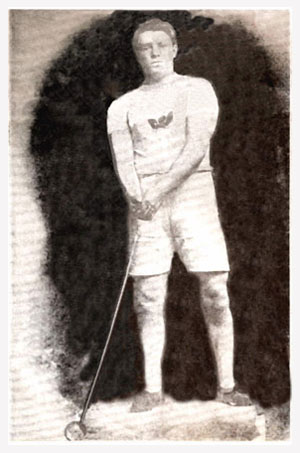
Nature endowed the 6’ 3” Ryan with a magnificent frame, his build, from the knees up, depicting strength in every line and curve, while, together with this all-important attribute, he was possessed of a pair of small and shapely feet which would do credit to a ballet dancer… a rare combination. Landing in America in an era of hammer throwers extraordinary, he found Matt McGrath endangering John Flanagan’s world record, and Con Walsh little inferior. At the Irish-American (Athletic Club) Games of October, 1910, Pat, up to now almost exclusively tied to the old straight handled hammer, minus the triangular grip, sent an up-to-date implement over 165’ in an exhibition, and it was apparent that Flanagan, McGrath and Walsh must look to their laurels, for Matt, writing Tom Kiely, ventured this high opinion of the newcomer: “Ireland has sent us another great hammerman…perhaps the greatest of all.”
Pat’s first try for an American title was at Forbes Field, Pittsburgh, in July, 1911, and he secured third place behind Walsh and McGrath, but, a month later, he went within inches of McGrath at Celtic Park, with a throw of over 179’, and then definitely established himself by taking the New York Senior Metropolitan hammer title at a shade under 175’.
In 1912 he retained his New York title, at Travers Island, and McGrath, then world record holder, also in the competition, became badly flustered, fouling all of his efforts. Ryan, in his best essay, threw straight across the ground and smashed the bell at the finish of the 100 yards, the distance reading 182’ 11¾”. He was unlucky in the American Championship a fortnight later, losing by 2ft. to McGrath, but beat Pat McDonald and McGrath for the 56lbs. title, doing close to 38’.
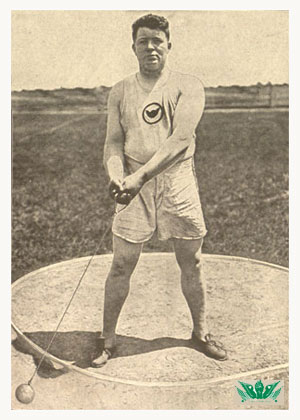
The Gaelic Athletic Association Championships of 1902 were held at Limerick on 16th September, and something like a sensation was caused there by a tall, rangy youth of 19 years, Pat Ryan of Pallasgreen, Co. Limerick, who beat the famous Tom Kiely for the hammer throwing crown, at moderate mark, admittedly, of 136’. It was, nevertheless, the first time for a long number of years that Kiely was beaten on level terms, excepting by John Flanagan, but this young conqueror blossomed into perhaps the greatest natural hammerman that Ireland, or the world, has produced. A few have beaten his figures in the European theatre, but these adhered to a much more careful mode of life, and systematic training, for Ryan was one to speedily turn his trainers grey-haired. What John L. Sullivan was in boxing, Ryan was in athletics, almost to the letter.
From 1902 to 1909, he won several Irish Championships, his best effort in these being 154’ 5”, in 1909, and his admirers were, by this time, bewailing the fact that he was not fulfilling early promise. The reason was that Pat, one of the very few lucky enough to hit upon the proper method of hammer throwing from the beginning, did not get down to serious training over any prolonged period. He was the superior man in his own land and was quite content to let matters rest at that.
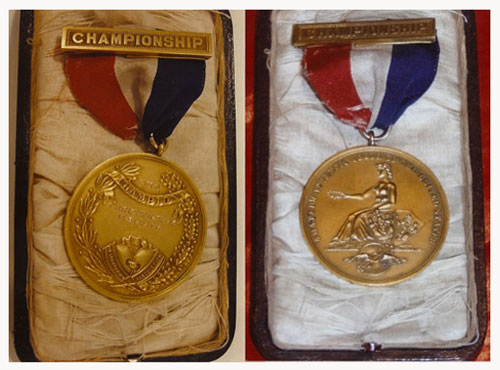
The battle of the titans between Ryan and McGrath went on with even greater intensity during 1914, Pat winning the American hammer crown with a Championship record of more than 183’, with Matt 4ft. away, while the culminating point came in the New York Senior Championships of 3rd October, the hammer standard reached in these being the highest ever attained by two men in the one competition on the American continent, Ryan winning at 186’ 2”, and McGrath registering 181’ 11”. In this year Ryan made an American 28lbs. record of 36’ 8½“.
Again, in 1915, Pat took the American Championship hammer event, held in conjunction with the Panama-Pacific Exposition, San Francisco, doing 176’, and the New York Senior at a fraction short of 177’, with McGrath but 2ft. behind. Pat’s best performance of this year was 187’ 4” hammer throw at Celtic Park. McGrath was lucky in wrestling the New York 56lbs. title from Ryan, by an inch.
Having taken the American hammer Championship of 1916, at Newark, New Jersey, beating McGrath 15ft., and annexed hammer and 56lbs. titles of 1917, Pat sailed for France with the American Expeditionary Force. He and the famous Gene Tunney, conqueror of Jack Dempsey, saw some rough service there, became fast friends, and they still correspond. Home on leave in 1919, Ryan took the Irish Amateur Athletic Association Championship at Lansdowne Road, doing 189’, and then departed for the New World to regain the American hammer title with a 175’ throw at Franklin Field, Philadelphia, beating McGrath, the holder in his absence, by several feet.
The American Championship of 1920 also served as Olympic Tryouts, and Ryan, the hammer winner, with 3ft. to spare from McGrath, was America’s No. 1 choice for the Antwerp Olympiad. McGrath wrenched a knee in the qualifying rounds at Antwerp, and was unable to take his place in the final the following day, although his throw counted and brought him fifth place. The opposition in the final was not therefore what it would have been in other years. Ryan at this time was 37 years old, and most weighed in the neighborhood of 19 stones (266 pounds). In practice, during the preceding week, he beat 181ft., but conditions were adverse on the day of the final, specially for a heavily built man. Rain fell all through the afternoon, and the circle, of grass, was greatly cut up by the throwers, leaving Ryan little scope for a big throw. However, he beat 173’ for an easy win, the second man, Carl Lindh of Sweden, being short of 160ft. Pat also placed second here to Pat McDonald, in throwing the 56lbs. from the circle, the last occasion on which the event was put on an Olympic programme.
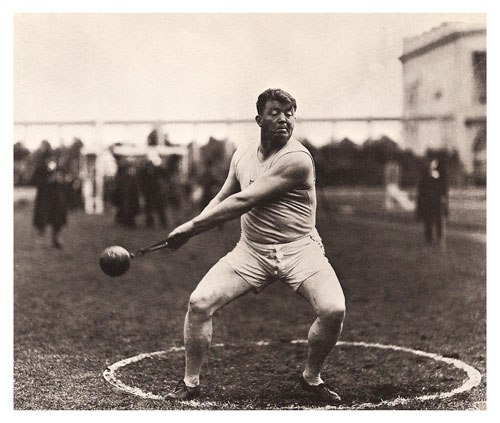
Nineteen years after winning his first Irish title, Ryan took his last American Championship, on Independence Day, 1921, at far-away Pasadena, California, where he was still good enough to beat 170’ with the hammer and was runner-up to McDonald in throwing the 56lbs. Following his return to his native Limerick, on retirement, he proved a very able coach, his nephew, Patrick M. Ryan, of Emly, being his outstanding pupil. The latter, in August, 1930, when weighing just 12 stone 7lbs. (175 pounds), and aged 20 years an 9 months, threw a 16lbs. hammer 166’ 4” at Tipperary Town, which performance alone places him in line with the greatest exponents, pound for pound. John Doherty, ex N.A.&C.A.(I.) Champion, still in competition, who has beaten 160’, is also a pupil of the old world record holder.
Patrick J. Ryan is now farming near Pallasgreen, in quiet seclusion, far removed from the scenes of his triumphs and the thunderous acclamation of tens of thousands. There are times when the memories of a wonderful life and the great moments he knew must indeed stab and burn, but he may at least rest assured that, as long as athletic history is written, a prominent page will be reserved for his extraordinary exploits.
He won 11 Irish, 10 American Senior Outdoor, and 1 Olympic Championship.
(For a printer friendly, Acrobat PDF version of this article, click here).
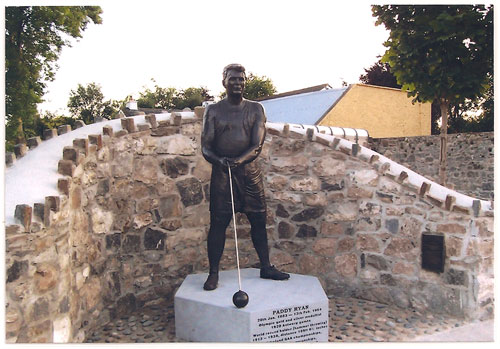
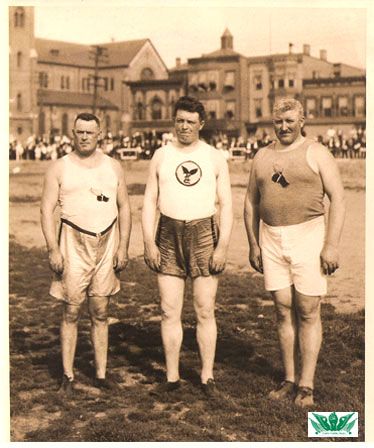
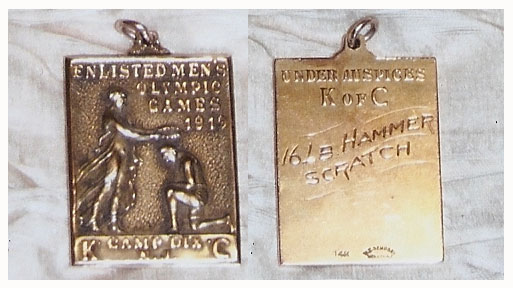
1913 was Ryan’s big year. He won the American hammer crown at Grant Park, Chicago, at 177’ 7¾“, a Championship record, and broke McGrath’s world record of 187’ 4”, with 189’ 6½“ at the (Eccentric) Firemen’s Games, Celtic Park. Behind on handicap up to the sixth and last effort, he achieved his greatest with a half a foot to spare in the front of the circle. This mark remained a world record for a quarter of a century. The worth of Ryan’s magnificent performance of 1913 can also be assessed at something like its real value, by reason of the fact, that the hammer event is the only standard event on the American athletic programme, in which fresh figures have not been shown in the intervening years.
Four special weight events were put on by the Irish-American (Athletic) Club, at Celtic Park, in 1st September, 1913, and there Pat smashed three more world records, throwing the hammer 189’ 3” from a 9’circle, pushing a 42lbs. 28’ 11¼“, and flinging a 35lbs. weight over 57’ from a circle. Three weeks afterwards he reached 185’ with the hammer and beat 40’ with the 56lbs., both hands, in taking two more New York Senior Championships, the latter figures being but inches short of the best on record by Matt McGrath. In that year also, Pat, in the Indoor Games of the Irish-American (Athletic) Club, Madison Square Garden, pushed a 56lbs. an unprecedented 25’ feet from the shoulder…
In July, 1914, at Buffalo, Ryan was credited with flinging a 12lbs. hammer 225’, but the mark was not ratified by the athletic authorities. His 213’ 9½ “, of the previous Autumn, at Celtic Park, has never been surpassed in a certified throw.